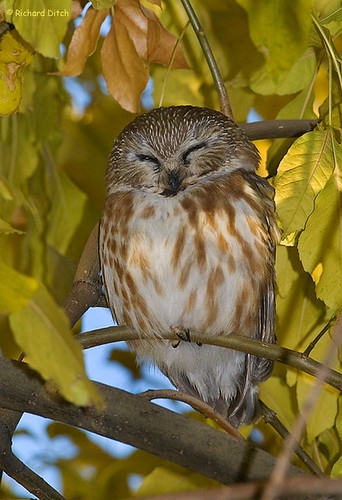tags: Northern Saw-Whet Owl, Aegolius acadicus, birds, mystery bird, bird ID quiz
[Mystery bird] Northern Saw-Whet Owl, Aegolius acadicus, photographed in Arizona. [I will identify this bird for you tomorrow]
Image: Richard Ditch, 2007 [larger view].
Date Time Original: 2007:01:03 16:32:23
Exposure Time: 1/60
F-Number: 11.00
ISO: 200
Please name at least one field mark that supports your identification.
Rick Wright, Managing Director of WINGS Birding Tours Worldwide, writes:
I think it's an ash, but whatever the identity of the foliage, those would have to be mighty leaves indeed were this anything but a tiny owl. The short tail eliminates all of the pygmy-owls -- and that's a fortunate thing indeed, as the visual identification of the various taxa in that genus is a bit of a nightmare.
The lack of "horns" and the warm buffy stripes on the underparts point to Northern Saw-whet Owl. Just to be certain, we note that that finely streaked forehead and dark bill are consistent with that species and not with Boreal (Tengmalm's) Owl, while Unspotted Saw-whet Owl is, well, unspotted. The much smaller Elf Owl -- an id contender that had not occurred to me -- is diffusely marked beneath, unmarked on the crown, and completely different in shape. Where Northern Saw-whet is a compact, blocky little bird, Elf Owl is small-headed and slender.


Based on a streaked, as opposed to spotted, crown, I'm going to call that a ferruginous pygmy-owl.
Now, if I could just do it without a Sibley guide in my hands I'd be a holy terror. :-)
Oops. Darn it. Spoke too soon. Even more embarrassing for me, I actually said "saw-whet" to myself before I went to the field guide, then failed to check that species before pulling the trigger.
In hindsight, I should have paid more attention to the length (or lack thereof) of the tail.
Saw-whet Owl. Chestnut colored streaks on breast, fine white streaks on crown, short tail. An easy ID and a bird I've seen, photographed and drawn up close and personal as they are ridiculously tame and allow a close approach.
Looks more like an Elf Owl to me - it's beentsy, judging by the leaves around it, and the pictures have less white around the eyes for this bird to have none of....
it's an owl.
woot! :)
awwww.... If saw-whet is right, JohnB is correct, a very tame owl. I seldom see them, but when I have, they are very unconcerned about my presence. I had to hop up and down and wave my arms to get one to look at me, briefly, disdainfully. Or so it seemed. rb
"beentsy" !!!
i thought i was the only person who has ever used this word!
I think saw-whet owl.
Oops. The chestnut streaky breast, and the tinyness. The white along the eyes would be more prominent if they were open, I think.
Northern Saw-whet Owl. The small size in relation to the leaves around it, and the streaky cinnamon chest. (The anime eyes help, too.)
Northern Saw-whet Owl.
But missing the "V" shaped white above the beak and eyes as shown in Sibley. But Peterson states that this feature is found on young birds in summer. OK, the turning leaves in Arizona would make it late fall not summer.
So, what kind of tree is that? I spent more time with my tree guide than bird guide and concluded American Beech until I saw the map which showed it as an eastern tree.
According to Kaufman,the bird "Breeds most commonly in coniferous forest". But the range map dips down into Arizona where this photo was taken. And Kaufman also states "In some places, breeds in oak woodland or in streamside groves in arid country."...
As you may tell, I've been reading Sherlock Holmes lately.
According to Sibley, the Elf Owl has a pale bill and the Northern Saw-whet Owl has a dark one. Also, Sibley's range map says the Elf Owl's are gone from Arizona in winter. (The picture is dated Jan. 3.) So I'm voting for Saw-whet. If I'm right, do I get my life Saw-whet this winter?